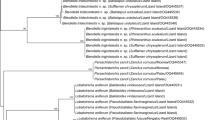Abstract
Choerodonicola Cribb, 2005 is a minor genus of opecoelid trematodes defined for species with exceptionally small eggs but otherwise generalised morphology. Four species are currently recognised, all from fishes collected in Japanese waters but each from different perciform families: a labrid, a scarid, a sparid and pinguipeds. We report on a new species, Choerodonicola arothokoros n. sp., from the blue-barred parrotfish Scarus ghobban Forsskål (Scaridae) collected in subtropical waters of Moreton Bay, south-east Queensland, Australia. Using genetic sequence data for the ITS2 rDNA marker, we matched adult C. arothokoros to intramollsucan stages discovered in an intertidal gastropod Herpetopoma atratum (Gmelin) (Vetigastropoda: Chilodontidae) collected in close proximity to the fish hosts. Notably, the cercariae lack a penetration stylet and are among the smallest known in the Opecoelidae. We provide the first assessment of the phylogenetic position of Choerodonicola based on sequence data generated for the phylogenetically informative 18S and 28S rRNA coding regions, for C. arothokoros and also C. renko Machida, 2014, which we recollected from the yellowback seabream Dentex hypselosomus Bleeker from the fish market in Minabe, Wakayama Prefecture, Japan. In our analyses, species of Choerodonicola resolved to neither of the major marine Plagioporinae (sensu lato) clades, clustering instead with Trilobovarium parvvatis Martin, Cutmore & Cribb, 2017, Podocotyloides parupenei (Manter, 1963) Pritchard, 1966 and Macvicaria magellanica Laskowski, Jeżewski & Zdzitowiecki, 2013. This clade is phylogenetically distinctive such that it has the potential to be recognised as a new opecoelid subfamily, but further investigation is required to establish the bounds for such a grouping and to determine the morphological and/or life-history patterns reflected by the phylogeny. Finally, we propose C. interruptus (Manter 1954) n. comb. for a species previously recognised in Plagioporus Stafford, 1904 and known only from Pseudolabrus miles (Schneider & Forster), a labrid endemic to New Zealand.



Similar content being viewed by others
References
Aken’Ova, T. O. L., & Cribb, T. H. (2000). Diplobulbus brayi n. sp. (Digenea: Opecoelidae) from Odax acroptilus (Perciformes: Odacidae) off Western Australia. Systematic Parasitology, 46, 99–103.
Andres, M. J., Pulis, E. E., & Overstreet, R. M. (2014a). New genus of opecoelid trematode from Pristipomoides aquilonaris (Perciformes: Lutjanidae) and its phylogenetic affinity within the family Opecoelidae. Folia Parasitologica, 61, 223–230.
Andres, M. J., Ray, C. L., Pulis, E. E., Curran, S. S., & Overstreet, R. M. (2014b). Molecular characterization of two opecoelid trematodes from fishes in the Gulf of Mexico, with a description of a new species of Helicometra. Acta Parasitologica, 59, 405–412.
Antar, R., Georgieva, S., Gargouri, L., & Kostadinova, A. (2015). Molecular evidence for the existence of species complexes within Macvicaria Gibson & Bray, 1982 (Digenea: Opecoelidae) in the western Mediterranean, with descriptions of two new species. Systematic Parasitology, 91, 211–229.
Barnett, L. J., Miller, T. L., & Cribb, T. H. (2014). A review of the currently recognised opecoelid cercariae, including the identification and emergence ecology of Cercaria capricornia XII (Digenea: Opecoelidae) from Nassarius olivaceus (Gastropoda: Nassariidae) in Central Queensland, Australia. Parasitology International, 63, 670–682.
Born-Torrijos, A., Kostadinova, A., Raga, J. A., & Holzer, A. S. (2012). Molecular and morphological identification of larval opecoelids (Digenea: Opecoelidae) parasitising prosobranch snails in a Western Mediterranean lagoon. Parasitology International, 61, 450–460.
Bray, R. A., Cribb, T. H., Littlewood, D. T. J., & Waeschenbach, A. (2016). The molecular phylogeny of the digenean family Opecoelidae Ozaki, 1925 and the value of morphological characters, with the erection of a new subfamily. Folia Parasitologica, 63, 1–11.
Bray, R. A., Waeschenbach, A., Cribb, T. H., Weedall, G. D., Dyal, P., & Littlewood, D. T. J. (2009). The phylogeny of the Lepocreadioidea (Platyhelminthes, Digenea) inferred from nuclear and mitochondrial genes: Implications for their systematics and evolution. Acta Parasitologica, 54, 310–329.
Cribb, T. H. (1989). Fairfaxia lethrini, gen. et sp. nov. (Digenea: Opecoelidae), from Lethrinus chrysostomus Richardson from the Southern Great-Barrier-Reef. Australian Journal of Zoology, 37, 67–70.
Cribb, T. H. (2005). Family Opecoelidae Ozaki, 1925. In: Jones, A., Bray, R. A. & Gibson, D. I. (Eds), Keys to the Trematoda Vollume 2. Wallingford, UK: CABI Publishing and The Natural History Museum, pp. 443–531.
Cribb, T. H., & Bray, R. A. (2010). Gut wash, body soak, blender and heat-fixation: Approaches to the effective collection, fixation and preservation of trematodes of fishes. Systematic Parasitology, 76, 1–7.
Cribb, T. H., Bray, R. A., Littlewood, D. T. J., Pichelin, S., & Herniou, E. A. (2001). The Digenea. In: Littlewood, D. T. J. & Bray, R. A. (Eds), Interrelationships of the Platyhelminthes. London: Taylor & Francis, pp. 168–185.
Dobrovolny, C. G. (1939). Life history of Plagioporus sinitsini Mueller and embryology of new cotylocercous cercariae (Trematoda). Transactions of the American Microscopical Society, 58, 121–155.
Edgar, R. C. (2004). MUSCLE: Multiple sequence alignment with high accuracy and high throughput. Nucleic Acids Research, 32, 1792–1797.
Faltýnková, A., Georgieva, S., Kostadinova, A., & Bray, R. A. (2017). Biodiversity and evolution of digeneans of fishes in the Southern Ocean. In: Klimpel, S., Kuhn, T. & Mehlhorn, H. (Eds). Biodiversity and Evolution of Parasitic Life in the Southern Ocean. Parasitology Research Monographs. Switzerland: Springer International Publishing, pp. 49–74.
Fayton, T. J., & Andres, M. J. (2016). New species of Plagioporus Stafford, 1904 (Digenea: Opecoelidae) from California, with an amendment of the genus and a phylogeny of freshwater plagioporines of the Holarctic. Systematic Parasitology, 93, 731–748.
Gibson, D. I. (2014). Plagioporinae Manter, 1947. Accessed through: World Register of Marine Species at http://www.marinespecies.org/aphia.php?p=taxdetails&id=391367. Accessed on 2017-12-01.
Gibson, D. I., & Bray, R. A. (1982). A study and reorganization of Plagioporus Stafford, 1904 (Digenea: Opecoelidae) and related genera, with special reference to forms from European Atlantic waters. Journal of Natural History, 16, 529–559.
Hildebrand, J., Sitko, J., Zaleśny, G., Jeżewski, W., & Laskowski, Z. (2016). Molecular characteristics of representatives of the genus Brachylecithum Shtrom, 1940 (Digenea, Dicrocoeliidae) with comments on lifecycle and host specificity. Parasitology Research, 115, 1417–1425.
Huston, D. C., Cutmore, S. C., & Cribb, T. H. (2017). Molecular phylogeny of the Haplosplanchnata Olson, Cribb, Tkach, Bray and Littlewood, 2003, with a description of Schikhobalotrema huffmani n. sp. Acta Parasitologica, 62, 502–512.
ICZN (2012). International Commission on Zoological Nomenclature: Amendment of articles 8, 9, 10, 21 and 78 of the International Code of Zoological Nomenclature to expand and refine methods of publication. Bulletin of Zoological Nomenclature, 69, 161–169.
Iwatsuki, Y., Akazaki, M., & Taniguchi, N. (2007). Review of the species of the genus Dentex (Perciformes: Sparidae) in the western Pacific defined as the D. hypselosomus complex with the description of a new species, Dentex abei and a redescription of Evynnis tumifrons. Bulletin of the National Museum of Nature and Science Series A, 1, 29–49.
Keller, A., Schleicher, T., Schultz, J., Muller, T., Dandekar, T., & Wolf, M. (2009). 5.8S-28S rRNA interaction and HMM-based ITS2 annotation. Gene, 430, 50–57.
Lanfear, R., Calcott, B., Ho, S. Y. W., & Guindon, S. (2012). PartitionFinder: Combined selection of partitioning schemes and substitution models for phylogenetic analyses. Molecular Biology and Evolution, 29, 1695–1701.
Laskowski, Z., Jeżewski, W., & Zdzitowiecki, K. (2013). Description of a new opecoelid trematode species from nototheniid fish in the Beagle Channel (Sub-Antarctica). Journal of Parasitology, 99, 487–489.
Machida, M. (2014). Seven species of opecoelid digeneans (Trematoda) from fishes of southern Japan, Palau and the Philippines. Bulletin of the National Science Museum, Tokyo, Series A, Zoology, 40, 1–13.
Machida, M., Ichihara, A., & Kamegai, S. (1970). Digenetic trematodes collected from the fishes in the sea north of the Tsushima Islands. Memoirs of the National Science Museum, Tokyo, 3, 101–112.
Manter, H. W. (1954). Some digenetic trematodes from fishes of New Zealand. Transactions of the Royal Society of New Zealand, 82, 475–568.
Martin, S. B., Cutmore, S. C., & Cribb, T. H. (2017). Revision of Neolebouria Gibson, 1976 (Digenea: Opecoelidae), with Trilobovarium n. g., for species infecting tropical and subtropical shallow-water fishes. Systematic Parasitology, 94, 307–338.
Martin, S. B., Cutmore, S. C., & Cribb, T. H. (2018). Revision of Podocotyloides Yamaguti, 1934 (Digenea: Opecoelidae), resurrection of Pedunculacetabulum Yamaguti, 1934 and the naming of a cryptic opecoelid species. Systematic Parasitology, 95, 1–31.
Miller, M. A., Pfeiffer, W., & Schwartz, T. (2010). Creating the CIPRES Science Gateway for inference of large phylogenetic trees. In Proceedings of the Gateway Computing Environments Workshop (GCE), 14 Nov 2012, New Orleans, LA, pp. 1–8.
Olson, P. D., Cribb, T. H., Tkach, V. V., Bray, R. A., & Littlewood, D. T. J. (2003). Phylogeny and classification of the Digenea (Platyhelminthes: Trematoda). International Journal for Parasitology, 33, 733–755.
Rima, M., Marzoug, D., Pérez-del-Olmo, A., Kostadinova, A., Bouderbala, M., & Georgieva, S. (2017). New molecular and morphological data for opecoelid digeneans in two Mediterranean sparid fishes with descriptions of Macvicaria gibsoni n. sp. and M. crassigula (Linton, 1910) (sensu stricto). Systematic Parasitology, 94, 739–763.
Ronquist, F., Teslenko, M., van der Mark, P., Ayres, D., Darling, A., Höhna, S., et al. (2012). MrBayes 3.2: Efficient Bayesian phylogenetic inference and model choice across a large model space. Systematic Biology, 61, 539–542.
Stamatakis, A. (2014). RAxML version 8: A tool for phylogenetic analysis and post-analysis of large phylogenies. Bioinformatics, 30, 1312–1313.
Tamura, K., Stecher, G., Peterson, D., Filipski, A., & Kumar, S. (2013). MEGA6: Molecular evolutionary genetics analysis version 6.0. Molecular Biology and Evolution, 30, 2725–2729.
Tkach, V. V., Pawlowski, J., Mariaux, J., & Swiderski, Z. (2001). Molecular phylogeny of the suborder Plagiorchiata and its position in the system of Digenea. In: Littlewood, D. T. J. & Bray, R. A. (Eds), Interrelationships of the platyhelminthes. London: Taylor & Francis, pp. 186–193.
Yamaguti, S. (1934). Studies on the helminth fauna of Japan. Part 2. Trematodes of fishes. I. Japanese Journal of Zoology, 5, 249–541.
Yamaguti, S. (1938). Studies on the helminth fauna of Japan. Part 21. Trematodes of fishes, IV. Tokyo: Maruzen Co.
Yamaguti, S. (1940). Studies on the helminth fauna of Japan. Part 31. Trematodes of fishes, VII. Japanese Journal of Zoology, 9, 35–108.
Acknowledgements
We thank the staff of Moreton Bay Research Station for their continued support enabling field collecting; A/Prof. Sho Shirakashi, Kindai University, Osaka for facilitating collection in Japan and confirming identification of Japanese sparids; an anonymous reviewer for a thorough and insightful critique which significantly improved the manuscript; and our colleague, Nicholas Wee, for assistance in the field and accidentally catching the first infected S. ghobban.
Funding
SBM and DCH are each supported by The Holsworth Wildlife Research Endowment and The Ecological Society of Australia. SBM is supported by a PhD scholarship provided through the Australian Government’s Australian Biological Resources Study (ABRS) National Taxonomy Research Grant Programme (NTRGP), Grant Number CT215-14. DCH is supported by a Moreton Bay Research Station scholarship in partnership with Sibelco Australia. Collection within Moreton Bay was part of a larger effort to characterise the metazoan parasite fauna of fishes from that region, funded by an ABRS Grant (RF215-40) awarded to SCC and THC. Collection in Japan was funded by an Australian Society for Parasitology (ASP) Network Researcher Exchange, Training and Travel Award grant to SCC.
Author information
Authors and Affiliations
Corresponding author
Ethics declarations
Conflict of interest
The authors declare that they have no conflict of interest.
Ethical approval
This study was conducted in compliance with all institutional, national and international guidelines on the care and use of animals.
Additional information
This article was registered in the Official Register of Zoological Nomenclature (ZooBank) as 73DF0D36-4FCF-4381-BA9F-635647224B55. This article was published as an Online First article on the online publication date shown on this page. The article should be cited by using the doi number. This is the Version of Record.
This article is part of the Topical Collection Digenea.
Rights and permissions
About this article
Cite this article
Martin, S.B., Cribb, T.H., Cutmore, S.C. et al. The phylogenetic position of Choerodonicola Cribb, 2005 (Digenea: Opecoelidae) with a partial life-cycle for a new species from the blue-barred parrotfish Scarus ghobban Forsskål (Scaridae) in Moreton Bay, Australia. Syst Parasitol 95, 337–352 (2018). https://doi.org/10.1007/s11230-018-9785-1
Received:
Accepted:
Published:
Issue Date:
DOI: https://doi.org/10.1007/s11230-018-9785-1




